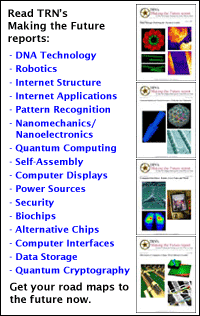
Crystal
turns heat to light
By
Kimberly Patch,
Technology Research NewsControlling the range of light wavelengths a material emits makes for more efficient lights. There's a lot of room for improvement in this area.
The tungsten filaments commonly used in lightbulbs, for instance, are notoriously inefficient, emitting only five to ten percent of the energy they use as light, and producing enough heat, or infrared radiation, to burn the skin of anyone unfortunate enough to touch a lightbulb that has been on for more than a few seconds.
Researchers from Sandia National Laboratories and Iowa State University have found a way to structure a tungsten filament so that, instead of emitting radiation made up of a broad mix of light and heat wavelengths, it emits 60 percent of the energy it receives in a relatively narrow band of wavelengths.
The wavelengths of visible light measure from about 400 to 700 nanometers from crest to crest, while heat wavelengths range from 700 to one million nanometers. A nanometer is one millionth of a millimeter.
Concentrating wavelengths paves the way for lights that emit more visible wavelengths than heat, drastically improving their efficiency.
The researchers' material, a type of photonic crystal, could also improve the efficiency of thermophotovoltaic devices, which convert heat to electricity, according to James Fleming, a researcher at Sandia National Laboratories.
Thermophotovoltaic devices convert heat to electricity the same way solar cells convert visible light to electricity. They produce electricity when photons from incoming light of certain wavelengths knock electrons loose from the semiconductor material that makes up the bulk of the device.
The Sandia photonic crystal promises to boost efficiencies by shifting a broad swath of wavelengths that make up the heat from a heat source to a narrower band of the optimal wavelengths for thermophotovoltaic cells to convert to electricity. When the researchers fed the properties of their material into a mathematical model of thermophotovoltaics they found that it could boost the efficiency of a thermophotovoltaic device to 51 percent, according to Fleming. By comparison, today's most efficient infrared emitters come in at just under 13 percent.
The researchers current prototype emits heat, but it is possible to shrink the crystal structure so that the narrow band it emits is within the wavelengths of visible light, said Fleming. "The structure needs to be shrunk by roughly a factor of eight to get into the visible" spectrum, he said.
The photonic crystals are made of tiny bars lined up like Lincoln logs at regular distances and angles. This artificial crystal latticework allows only certain wavelengths to pass through, and can also control the direction of those wavelengths. The material can be made using the same processes companies use to make computer chips, said Fleming.
These lattices are essentially the photonic counterparts to semiconductors. They control photon flow in a similar way to how computer chips control electron flow, said Fleming.
The researchers built the photonic crystal structure in silicon, then removed some of the silicon and exposed the structure to a chemical vapor to coat it with tungsten.
The discovery that this particular structure concentrated wavelengths was accidental, said Fleming. "The structure appears to be able to modify the range of wavelengths emitted by the filament. The odd emissive behavior was... not predicted. We came upon it in the course of other, related work," he said.
The researchers have not worked out the details of how the effect happens, said Fleming. "We need to better develop the theory behind the effect," he said.
The work is novel, said Eli Yablonovitch, a professor of electrical engineering at the University of California at Los Angeles. "It's... probably the first application of photonic crystals to the energy industry," he said.
The effect has the potential to increase the efficiency of small-scale devices that convert heat to electricity, he said. "It could lead to small portable electric generators that run on... fuel and that would produce electricity very efficiently. In general it's competitive with many other methods of producing electricity, but it's efficient even in a small unit," he said.
The research could lead to practical products in about five years, said Fleming. In terms of gaining a full understanding of the effect, "we should have a good idea of what is happening in about two years," he said. In addition, "there are... niche markets for efficient infrared sources which could benefit from what we have already demonstrated," he said.
Fleming's research colleagues were Shawn Y. Lin, Ihab El-Kady and Rana Biswas from Sandia and Kai-Ming Ho from Iowa State University. They published the research in the May 2, 2002 issue of the journal Nature. The research was funded by Sandia.
Timeline: 5 years
Funding: Government
TRN Categories: Materials Science and Engineering; Optical Computing, Optoelectronics and Photonics
Story Type: News
Related Elements: Technical paper, "All-Metallic Three-dimensional Photonic Crystals with a Large Infrared Bandgap," Nature, May 2, 2002.
Advertisements:
May 29/June 5, 2002
Page One
Speck-sized microscope nears
Crystal turns heat to light
Frozen reservoir fuels atom lasers
Groups key to network searches
Reverb keeps secrets safe and sound
News:
Research News Roundup
Research Watch blog
Features:
View from the High Ground Q&A
How It Works
RSS Feeds:
News
Ad links:
Buy an ad link
| Advertisements:
|
 |
Ad links: Clear History
Buy an ad link
|
TRN
Newswire and Headline Feeds for Web sites
|
© Copyright Technology Research News, LLC 2000-2006. All rights reserved.